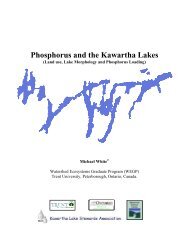Lake Water Quality 2006 Report - Lakefield Herald
Lake Water Quality 2006 Report - Lakefield Herald
Lake Water Quality 2006 Report - Lakefield Herald
You also want an ePaper? Increase the reach of your titles
YUMPU automatically turns print PDFs into web optimized ePapers that Google loves.
levels of these two inflows. Big Bald’s water averages about 12 ppb, whileNogie’s Creek water, measured at Bottom Island, averages about 18 ppb. Why?It may be because Nogie’s Creek is a slow-moving creek, draining an area withmany wetlands, which are often a source of phosphorus, whereas Big Bald <strong>Lake</strong>has low-phosphorus water. (See paragraph above.) Pigeon <strong>Lake</strong> also collectswater from the south via the Pigeon River.Buckhorn <strong>Lake</strong> and Lower Buckhorn <strong>Lake</strong>: phosphorus levels rise• Phosphorus levels in Buckhorn <strong>Lake</strong> and Lower Buckhorn <strong>Lake</strong> are 3 to 4 ppbhigher than in Pigeon <strong>Lake</strong>.Chemong <strong>Lake</strong>: low in the north, high in the south• Chemong <strong>Lake</strong> is a “dead-end” lake connected to the Trent-Severn <strong>Water</strong>wayand divided into two lakes by a causeway. At certain times of the year Chemongflows into the TSW; at other times, TSW water flows into Chemong; that is,the flow between Buckhorn <strong>Lake</strong> and Chemong <strong>Lake</strong> changes directionperiodically during the year. The two points measured on Chemong <strong>Lake</strong> hadvery different phosphorus levels. Poplar Point is a new testing site in <strong>2006</strong>. Itis near the middle of the lake, just south of the channel to Buckhorn. Itsphosphorus levels were below 15 ppb throughout the summer. Levels actuallydropped a bit in July and August and were slightly higher at the beginning andend of the season, which is most unusual for one of the TSW lakes. There is noobvious reason for the low July and August readings. Perhaps it is connected tocalcium carbonate (marl) precipitation, known to reduce phosphorus in thesummer. The other point, “S. end deep spot”, is in a narrow bay at the southerntip of the lake. It is very shallow in this bay, the “deep spot” being only about 2m. There is little circulation, it is shallow, the shore is densely populated withhomes, and a stream runs into the end of the bay from farmland. All of thesefactors may contribute to the higher phosphorus readings.Lower Buckhorn and Lovesick <strong>Lake</strong>s: phosphorus levels rise• Lower Buckhorn <strong>Lake</strong> and Lovesick <strong>Lake</strong> share the same lake basin; the waterfrom Lower Buckhorn spills into Lovesick over a chain of dams linking islandsthat separate the two lakes. Lower Buckhorn collects low phosphorus waterfrom the Mississagua River but in spite of this, phosphorus levels rise slightly.As in previous years, the phosphorus readings in Lovesick <strong>Lake</strong> are somewhathigher than in Buckhorn and Lower Buckhorn.21





